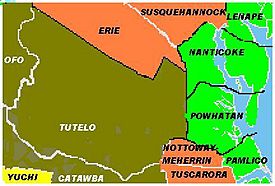Tutelo facts for kids

Map showing tribal lands of the Tutelo in 1565
|
|
| Total population | |
|---|---|
| Extinct as an independent tribe | |
| Regions with significant populations | |
| West Virginia, Virginia (c. 1270-1701, 1714-1740), North Carolina (1701-1714), Pennsylvania (1740-1753), New York (1753-1779), Ontario (1779-ca. 1900) (descendants assimilated into Cayuga nation) | |
| Languages | |
| Siouan Tutelo language | |
| Related ethnic groups | |
| Occaneechi, Manahoac, Monacan |
The Tutelo (also called Totero or Yesan in their own language) were a group of Native American people. They lived in what is now Virginia and West Virginia. They spoke a language called Tutelo language, which was part of the Siouan language family. This language was similar to those spoken by nearby tribes like the Monacan and Manahoac.
Because of pressure from English settlers and the Seneca Iroquois tribe, the Tutelo joined with other Siouan tribes in Virginia in the late 1600s. Together, they became known as the Tutelo-Saponi. By 1740, most of them had left Virginia. They moved north to find safety with their former Iroquois rivals. In 1753, the Cayuga tribe in New York adopted them.
What's in a Name?
The name Tutelo comes from a word the Iroquois used for all the Siouan tribes in Virginia. This word was Toderochrone. The Tutelo people had their own name for themselves, which was Yesañ or Yesan. This name is also linked to other old spellings like Nahyssan.
A Look at Tutelo History
The Tutelo people's original homeland was said to be near the Big Sandy River. This river is on the border of West Virginia and Kentucky. They called it the "Totteroy River." The Iroquois pushed them out of this area around 1670 during the Beaver Wars. After this, the Iroquois claimed the Ohio Valley as their hunting grounds.
Virginia records first mentioned a form of the name Tutelo in 1671. This was when the Batts and Fallam expedition visited "Totero Town" near what is now Salem, Virginia. A few years later, the Tutelo joined the Saponi. They lived on islands where the Dan River and Staunton rivers meet to form the Roanoke River. This area was just above the land of the Occaneechi tribe. For a time, the Tutelo also had a village on the banks of the New River. Pottery and small arrowheads found there suggest people lived there in the mid-1500s or early 1600s.
In 1701, the Tutelo were living near the start of the Yadkin River in North Carolina. After 1714, they were known as the Saponi-Tutelo. They lived near Fort Christanna in Brunswick County, Virginia, close to the North Carolina border.
During the 1730s, some Saponi, Tutelo, and Occaneechi people moved north. They went to Shamokin, Pennsylvania, seeking protection from the Oneida leader, Shickellamy. They later moved even further north into what is now western New York.
In 1753, the Cayuga nation in New York formally adopted these Siouan groups. Their village, called Coreorgonel, was near modern-day Ithaca, New York. They lived there safely with the Cayuga until 1779. During the American Revolutionary War, Coreorgonel and many other Iroquois towns were destroyed. This happened during the Sullivan Expedition, which was a response to British-Iroquois attacks on American rebels.
The Tutelo then went with the Iroquois to Canada. The British offered them land there for a new home. This land became known as the Six Nations of the Grand River First Nation. The Tutelo continued to live among the Cayuga. Over time, they became part of the Cayuga through marriage. The last known person who spoke the Tutelo language fluently was Nikonha. He was also called Waskiteng ("Old Mosquito"). He died in 1870 at 105 years old. He had shared a lot of information about his language with a scholar named Horatio Hale. This helped confirm that the Tutelo language was indeed Siouan.
Related Native American Nations
See also
 In Spanish: Tutelo para niños
In Spanish: Tutelo para niños

